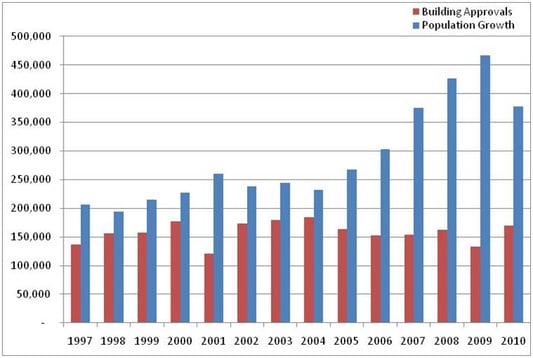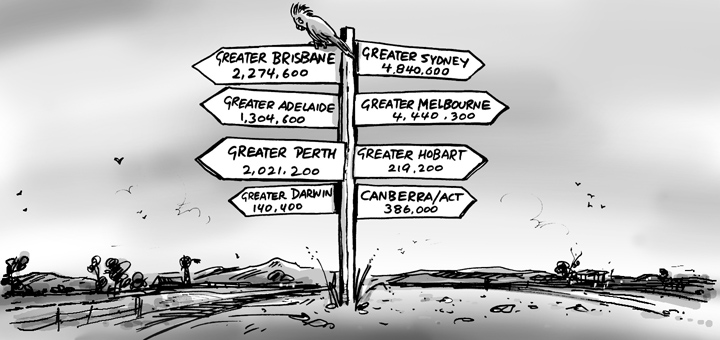Australia’s record population growth rate has begun to slow, driven by a decline in overseas migration, according to the latest issue of Australian Demographic Statistics published by the Australian Bureau of Statistics on 21 December 2010.
There are likely to be media headlines about a “population crash”, but what is the full story?
Population growth has peaked
In June 2010, Australia’s population was 22,342,000, up by 377,000 people in a year, or 1.7%. The headlines are that this population growth is slowing, but 377,000 in a year is still a pretty large increase! It only looks a little low compared to the 2009 figure, which was 466,000 or 2.2% up from the previous year. The chart below shows this in context.
Australian Population Growth and Building Approvals, 12 months ended June 1997 to 2010

Source: Australian Bureau of Statistics
While the annual figure is still pretty high, the growth is slowing rapidly. In the June 2010 quarter, Australia only added 70,534 people, while in 2008-09, this was consistently running at around 100-120,000 per quarter.
The chart also shows that despite record population growth over the past few years, the number of new dwelling approvals in Australia has been fairly consistent at around 150,000 to 170,000 per annum. This means that average household size is likely to have been increasing across Australia since 2007, reversing a trend of the past few decades. More on that in another article.
What’s causing the slow down?
We’re still having lots of babies, so natural increase (the number of extra births we have over the number of deaths) has been consistent for a while at about 40,000 per quarter. This means that the slow down must be caused by lower rates of overseas migration. The net overseas migration figure for the June quarter is only just over 32,000, about half that of the previous quarter, and around a third of the largest quarterly figure, 98,000 in March 2009, when migration peaked.
As far as net migration goes, remember it’s not just about people coming into the country. That figure of 32,000 is comprised of about 91,000 coming in and 59,000 leaving the country.
How do the States compare?
Western Australia is still the fastest growing state, adding 49,000 people, or 2.2%, while Tasmania was the slowest, adding 4,400 or 0.9%. However, Tasmania still gained slightly in migrants from other states, while the largest gains were into Queensland, WA and Victoria. New South Wales, as usual, lost people interstate, as did South Australia and the NT.

Source: Australian Bureau of Statistics
What about local areas?
In March 2011 we get the local update, which gives figures for each Local Government Area for June 2010. In the previous edition, to June 2009 (which currently shows on the front page of every profile.id site) almost all LGAs in Australia gained population, some with very high growth rates due to the high rate of national growth. With the lower rate of growth nationally, it will be interesting to see what this means for each local area.
One thing also worth remembering is that these numbers are all subject to revision. They’re not final until after the next Census release. We’re coming up to a Census year, 2011, and when ABS gets the numbers from that, they work out whether they were too high or too low in all of their interim numbers. They can, and do sometimes change quite drastically, particularly at the local level.
If you found this information helpful, please share it with your colleagues.
.id is a team of demographers, population forecasters, spatial planners, urban economists, and data experts who use a unique combination of online tools and consulting to help governments and organisations understand their local areas. Access our free demographic resources here











